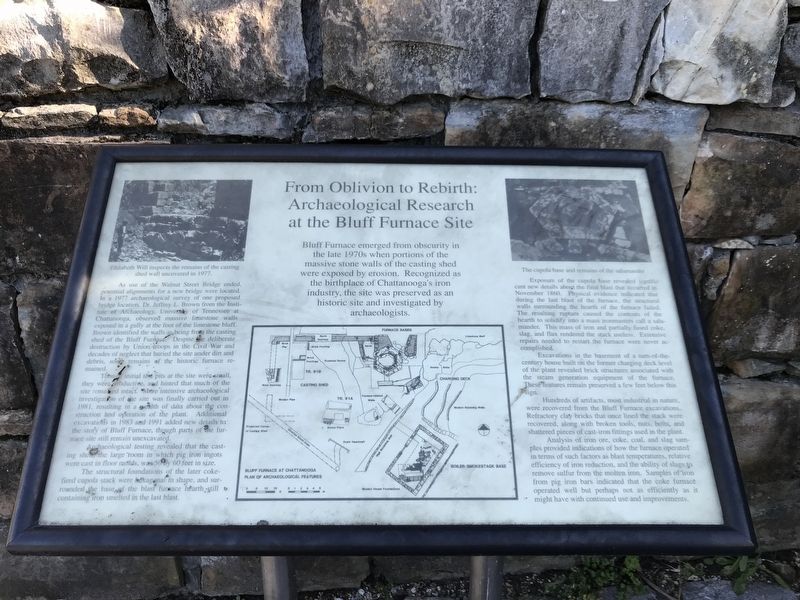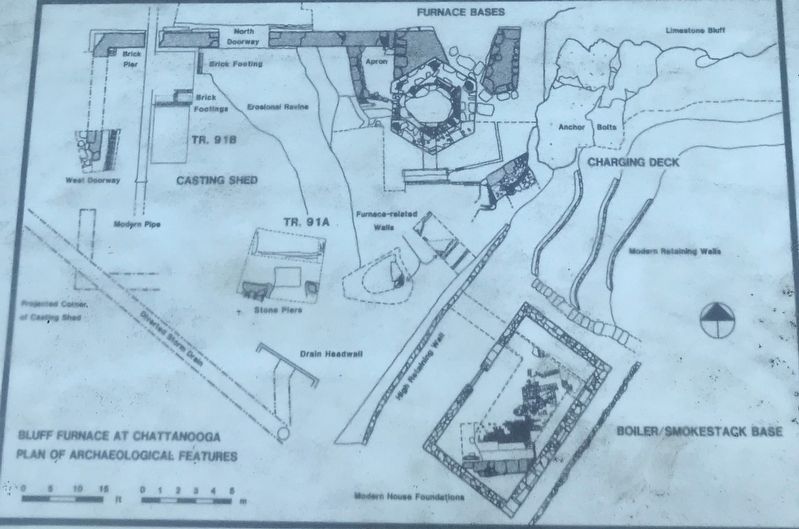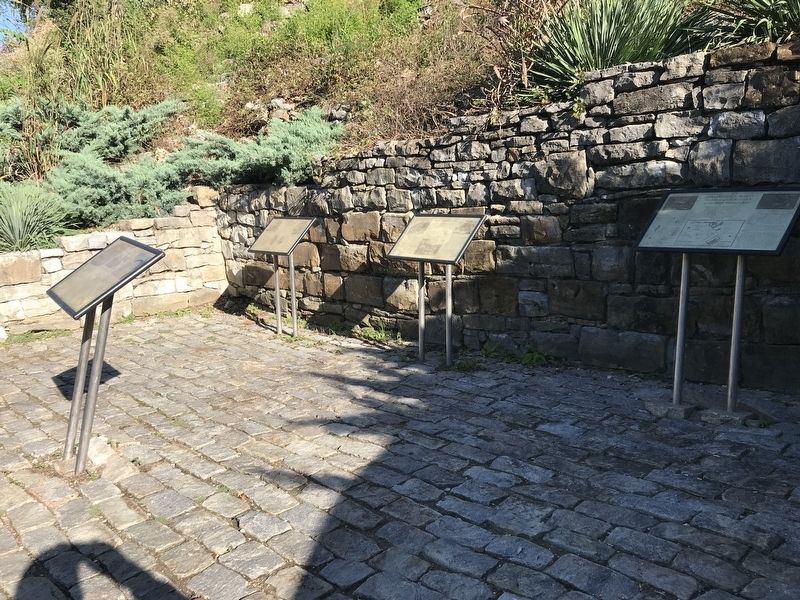Bluff View in Chattanooga in Hamilton County, Tennessee — The American South (East South Central)
From Oblivion to Rebirth: Archaeological Research at the Bluff Furnace Site
Inscription.
Bluff Furnace emerged from obscurity in the late 1970s when portions of the massive stone walls of the casting shed were exposed by erosion. Recognized as the birthplace of Chattanooga's iron industry, the site was preserved as an historic site and investigated by archaeologists.
As use of the Walnut Street Bridge ended, potential alignments for a new bridge were located. In a 1977 archaeological survey of one proposed bridge location, Dr. Jeffrey L. Brown from the Institute of Archaeology, University of Tennessee at Chattanooga, observed massive limestone walls exposed in a gully at the foot of the limestone bluff. Brown identified the walls as being from the casting shed of the Bluff Furnace. Despite the deliberate destruction by Union troops in the Civil War and decades of neglect that buried the site under dirt and debris, some remains of the historic furnace remained.
Though initial test pits at the site were small, they were productive, and hinted that much of the site remained intact. More intensive archaeological investigation of the site was finally carried out in 1981, resulting in a wealth of data about the construction and operation of the plant. Additional excavations in 1983 and 1991 added new details to the story of Bluff Furnace, though parts of the furnace site still remain unexcavated.
Archaeological testing revealed that the casting shed, the large room in which pig iron ingots were cast in floor molds, was 50 by 60 feet in size.
The structural foundations of the later coke-fired cupola stack were hexagonal in shape, and surrounded the base of the blast furnace hearth still containing iron smelted in the last blast.
Exposure of the cupola base revealed significant new details about the final blast that occurred in November 1860. Physical evidence indicated that during the last blast of the furnace, the structural walls surrounding the hearth of the furnace failed. The resulting rupture caused the contents of the hearth to solidify into a mass ironmasters call a salamander. This mass of iron and partially fused coke, slag, and flux rendered the stack useless. Extensive repairs needed to restart the furnace were never accomplished.
Excavations in the basement of a turn-of-the-century house built on the former charging deck level of the plant revealed brick structures associated with the steam generation equipment of the furnace. These features remain preserved a few feet below this sign.
Hundreds of artifacts, most industrial in nature, were recovered from the Bluff Furnace excavations. Refractory clay bricks that once lined the stack were recovered, along with broken tools, nuts, bolts, and shattered pieces of cast-iron fittings used in the
plant.
Analysis of iron ore, coke, coal, and slag samples provided indications of how the furnace operated in terms of such factors as blast temperatures, relative efficiency of iron reduction, and the ability of slags to remove sulfur from the molten iron. Samples of iron from pig iron bars indicated that the coke furnace operated well but perhaps not as efficiently as it might have with continued use and improvements.
Captions:
[Left] Elizabeth Will inspects the remains of the casting shed wall uncovered in 1977.
[Right] The cupola base and remains of the salamander.
Topics. This historical marker is listed in these topic lists: Anthropology & Archaeology • Bridges & Viaducts • Industry & Commerce. A significant historical year for this entry is 1977.
Location. 35° 3.366′ N, 85° 18.424′ W. Marker is in Chattanooga, Tennessee, in Hamilton County. It is in Bluff View. Marker can be reached from Bluff View Avenue. Marker is in an alcove by the Williams Stairway on the Tennessee Riverwalk. Touch for map. Marker is at or near this postal address: 10 Bluff View Ave, Chattanooga TN 37403, United States of America. Touch for directions.
Other nearby markers. At least 8 other markers are within walking distance of this marker. Innovation and Disaster (here, next to this marker); Bluff Furnace Historical Park (here, next to this marker); The Beginnings of Iron Manufacture in Chattanooga
(here, next to this marker); Bluff Furnace Historic Site (within shouting distance of this marker); Ross's Landing: River Crossing and Port (about 300 feet away, measured in a direct line); Hunter Museum of American Art (about 300 feet away); Headquarters Row (about 300 feet away); Site of Battery Smartt (about 300 feet away). Touch for a list and map of all markers in Chattanooga.
Credits. This page was last revised on February 7, 2023. It was originally submitted on October 19, 2021, by Duane and Tracy Marsteller of Murfreesboro, Tennessee. This page has been viewed 119 times since then and 16 times this year. Photos: 1, 2, 3. submitted on October 19, 2021, by Duane and Tracy Marsteller of Murfreesboro, Tennessee.


